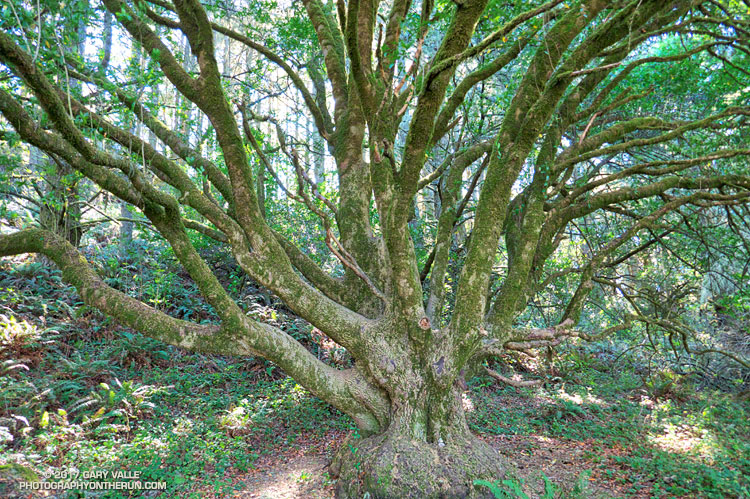
A sprawling coast live oak along the Sky Trail in Point Reyes National Seashore. From the run to Kelham Beach from the Bear Valley Visitor.

A sprawling coast live oak along the Sky Trail in Point Reyes National Seashore. From the run to Kelham Beach from the Bear Valley Visitor.
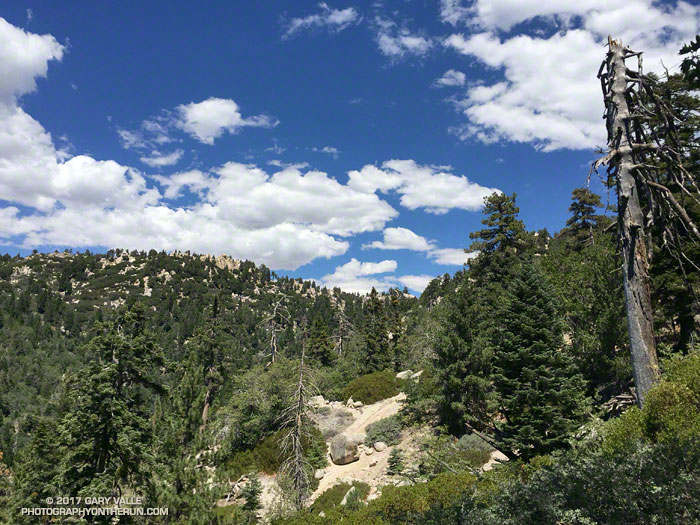
I had heard runners behind me since the last aid station. Now that we had passed the 8000′ high point of the course and were headed downhill, the group was going to pass me. I was at about mile 47 of the Kodiak 50 Mile race, and trying to shake off some demons that had been plaguing me for the last 7 miles.
It was my fourth Kodiak 50M and except for these last few miles it had been a mostly enjoyable day on the trails and forest roads of Big Bear Lake. There is no better run than a run in the mountains, and for my money no better 50 Mile race in Southern California than the Kodiak 50M. The Kodiak races (100M, 50M, Front 50K, Back 50K) have a character all their own, and at least for now — no lottery or histrionics. Just enter, train hard and then run!
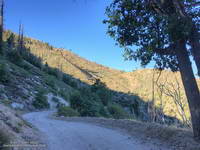
The race had started before dawn near Fawnskin, on the north side of Big Bear Lake. It had been a chilly forty-something degrees at the trailhead, but warmed quickly as we ascended the Grays Peak Trail. Today would be the first day of a record-setting heat wave in SoCal and temps for the race would be the warmest in its five year history. By the time we reached Snow Valley and were descending the windless, exposed, south-facing slopes of Bear Canyon, the “in the sun” temps would be around 100.
The highlight of the 50M race for me is the climb out of Bear Canyon on the Siberia Creek Trail. This classic 7 mile ascent gains around 2910′ from Bear Creek (4770′) to the Champion aid station (7680′). You only get to do the Siberia Creek climb when the 50M is run counter-clockwise around the west end of the lake. This has been the case each year except for 2016.
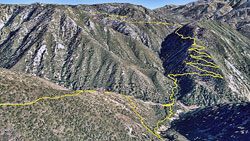
Expecting it to be hot and knowing how tough this climb can be, I filled my Camelbak(TM) to the brim and also took an extra bottle. (Thanks Aaron and Lacey!) What I didn’t do was take the time to cool off in the stream. A couple minutes of cooling here might have helped keep the race demons at bay.
It was deceivingly cool in the shade of the trees along Bear Creek, but that didn’t last long. By the time I got to the top of the Siberia Creek climb I was just about out of water, dehydrated and over-heated. I laughed when I thought about how cold it was here in 2013. That year racers resting at the Champion aid station huddled in blankets and sipped hot soup to try and stay warm. Not today! I tried to take the time to rehydrate, but the clock was ticking. I grabbed a cup of ice and started up the fire road.
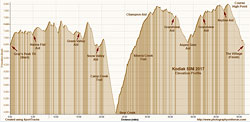
Though still generous, the cutoffs for the 50 milers have been substantially tightened since the 2015 event. Descending from the Grandview aid station to the Aspen Glen aid station I knew I was close to the cutoff and that was confirmed when a runner coming up the trail told me I only had 5 minutes remaining. The aid station personnel at Aspen Glen were phenomenal and I was in and out of there with water, my headlamp, and a couple of GUs in 48 seconds. I was excited to have made the cutoff, but knew I was going to have to push it to make the Finish by 9:00 p.m.
I had forgotten just how far east the Pine Knot Trail goes before ascending to Grandview. At one point it seemed the trail was going to descend all the way to the lake. I hadn’t seen a trail marker in some time and no other runners were in sight. I began to think I might have missed a turn and stopped to look more closely at the tracks on the trail. The imprints of a Brooks Cascadia and Altra Olympus stood out from the others. They were as good as a trail marker, and assured me I was still on course.
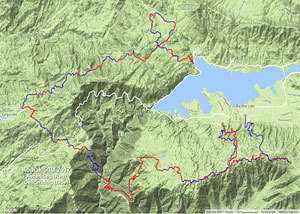
Eventually the Pine Knot Trail and I found our way back up to the Grandview aid station, but somewhere along the way I had become nauseated. Without asking, my body decided blood would be more useful for cooling and propulsion than for absorbing fluids and nutrients. My stomach had one message for me, “Sorry, we are closed!” It’s a common issue in longer runs, and given time, most runners work through it.
Unfortunately time was at a premium; all I could do is ralph, turn onto the Skyline Trail, and take the first steps toward the last aid station. I felt a little better after that and could sip a little water. The good news was that along with the sun, the temperature and my water requirements would be going down. What wasn’t going down was the trail. My recollection of this section was that it was a long five miles, but I did not recall all the ups along the way.
The last mile of the trail to the aid station paralleled the next section of the course and from time to time a runner would shout encouragement from the road above. I’d hoped to make it to the last aid station without having to stop and put on my headlamp and pulled into the station by the light of a quarter moon. Still nauseated, I put on my light and headed up the road.
Like a wrangler movin’ stock down from the high country, sweep Vanessa Kline encouraged the group of runners. We only had about 3 miles to go.
“You gotta keep running! You can do it! If you don’t run, you won’t make the cutoff!”
Most of the group did just that; they kept running and made the cutoff. Despite Vanessa’s best effort to get me moving a little faster, I crossed the finish line seven minutes after the 9:00 p.m. deadline.
I would have liked to make the cutoff, but I’m OK with the unofficial finish. I wasn’t trying to get UTMB points or to qualify for a 100 mile — I was running Kodiak for fun. I like the course and the way the event is organized. I’ve had faster Kodiak times and I’ve had slower. What didn’t change was that I was still smiling at the Finish.
Many thanks to R.D. Matt Smith, his supporting staff, all the volunteers, the sponsors, and runners. For all the results, photos and more info see the Kodiak web site and Facebook page. Also be sure to check out Kodiak 100M Winner Ruperto Romero’s interview on UltrarunnerPodcast.com. It’s a compelling and insightful story.
Some related posts: Kodiak 50 Mile 2015, Kodiak 50 Mile 2014, Kodiak 100 & 50 Mile Ultramarathons 2013
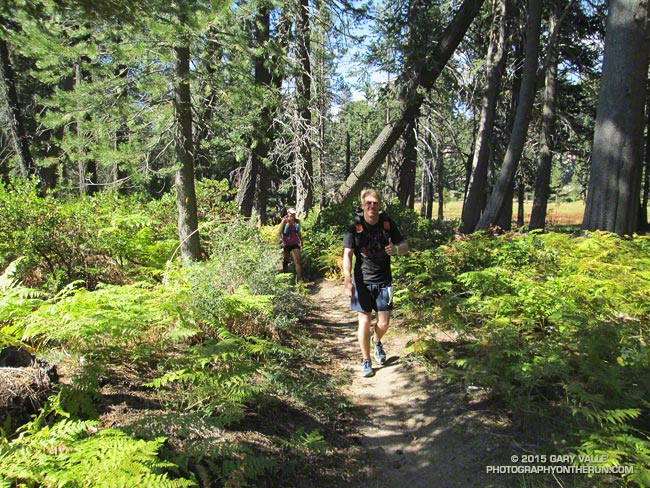
Dazzlingly bright and a day from full, the moon rose above the trees along the Snow Summit skyline. Ahead of the moon, Pegasus flew effortlessly across the eastern sky. I asked to borrow his wings, but in response heard only our footfalls and the wind in the pines.

We were on the Skyline Trail above Big Bear Lake and about 44 miles into the Kodiak 50 mile — one of four ultra-length running races organized by Matt Smith and crew for this Friday and Saturday.
The Kodiak 100 milers had started their circuit of Big Bear Lake at noon yesterday, and after running through the night, the fastest of the fast had finished the course this morning!
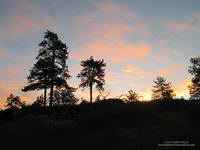
The Front 50K runners started on the heels of the 100 milers and ran the first 31 miles of the course — including the ascent of 10,000′ Sugarloaf Mountain. They finished yesterday evening at the Wildhorse aid station. Runners doing the Back 50K — the last 31 miles of the 100 mile course — started at Snow Valley at 8:30 this morning and most had finished by mid-afternoon.
We had started the 50 mile before sunrise at the Gray’s Peak trailhead, near Fawnskin, on the north shore of Big Bear Lake. Though warmer than normal, the temperature before sunrise was still in the 40s, and many shorts-clad runners huddled around the wheel wells of running cars trying to keep warm before the 6:00 am start. Continue reading Kodiak 50 Mile 2015

The contrast in temperature was remarkable. On a run at Ahmanson earlier in the week the temp had been over 100. Here on the north shore of Big Bear Lake it was about 60 degrees cooler.
It was 4:45 am and 54 two-legged runners, and one four-legged runner (Lacey) were scattered around the Meadow’s Edge Picnic Area. Some runners were sitting in cars with the motor on and heater running, some were checking in and picking up their bib numbers and making last minute preparations. One bare-armed runner in shorts and a singlet had appropriated a bathroom in lieu of a jacket.
At about 5:00 am were were on our way. The stars glittered brightly on an inky background of mountain sky. Surrounded by a frame of pines the iconic Winter constellation Orion ran across the southeastern sky, the brilliant dog star Sirius following at his side.
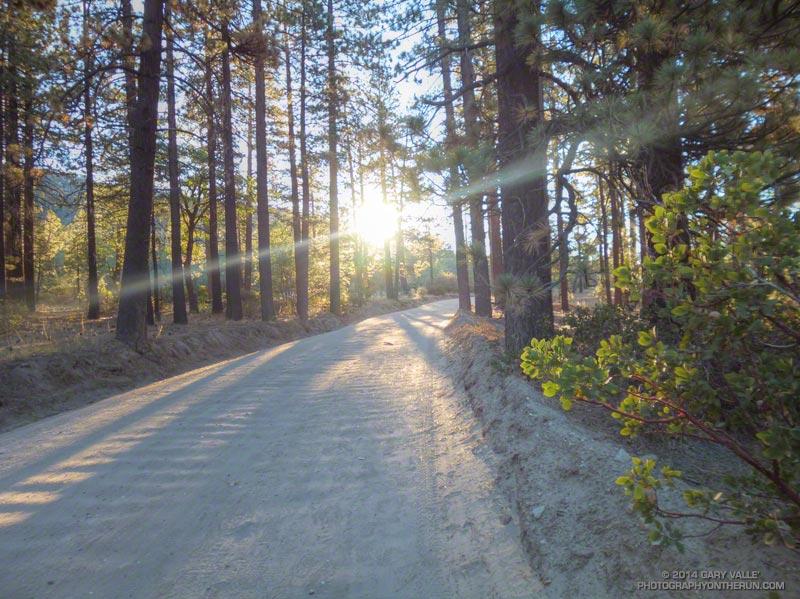
There were many changes and improvements for the 2014 edition of the Kodiak 100M & 50M. In addition to the 50M beginning at Meadow’s Edge and starting an hour earlier, nearly all of the miles to Rim Nordic (~ mile 23) were on dirt road. As much as I like single track, there were some significant benefits to this. Most importantly, it got us to Rim Nordic earlier in the day and in better shape to deal with the difficulties of the Siberia Creek section of the course.
The loss of the PCT single track on the first part of the 50 mile course was offset by the addition of the Skyline single track following the Siberia Creek climb. The Skyline and Siberia Creek Trails are both spectacular. When combined they are among the most challenging, aesthetic and rewarding trails in Southern California. Thanks to the trail work by the Big Bear Valley Trails Foundation and Kodiak volunteers the Siberia Creek Trail was in better shape this year.
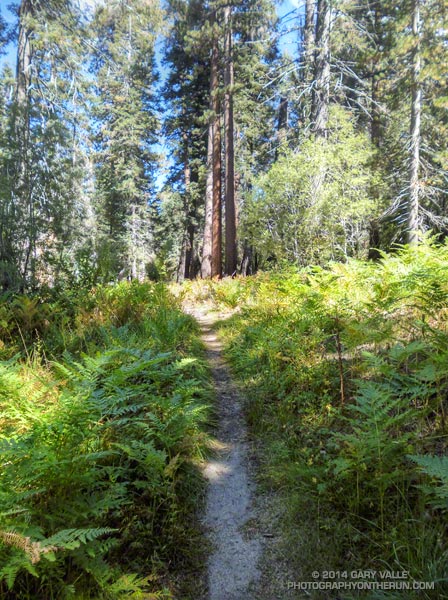
The weather was outstanding! Once the sun was up, my sleeves came off and it was shorts and short-sleeves for the remainder of the day. Reflecting the good weather, the changes in the course, the improved aid stations, and perhaps a better understanding of the character of the course, the finishing rates for both the 50M and 100M were up significantly from last year. Half of the runners that started the 100M finished and about 85% of the 50 milers finished.
Here are some photos taken during the 50 mile. The 50M/100M mileages mentioned in the descriptions are approximate.
Many thanks to R.D. Matt Smith and all of the event staff, volunteers, sponsors and runners! For more photos, stories, results and info checkout the Kodiak web site and Facebook page.
P.S. Lacey and her “Dad” Aaron Sorensen both finished the 50 mile in fine style!
Related post: Kodiak 100 & 50 Mile Ultramarathons 2013
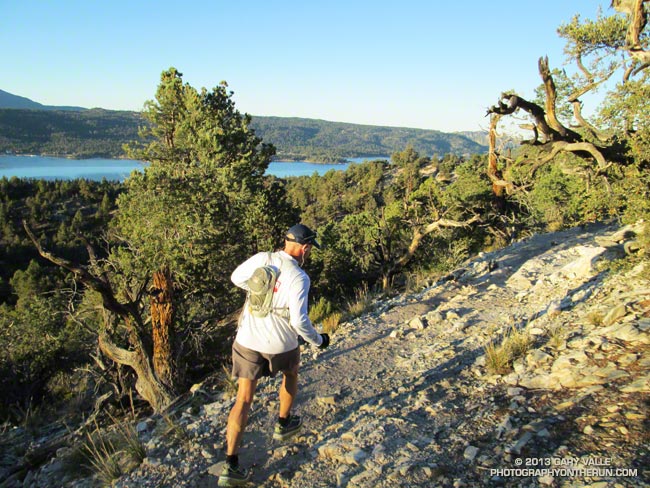
50 Mile Runner on the PCT Near Cougar Crest Junction
If you’ve driven to Big Bear on Highway 18, you’ve driven the dramatic, twisting, turning, mountain road that seems to be perched on the rim of the world. Whenever I’ve driven that highway I’ve always peered into the chasm it traverses with more than a little awe, some trepidation, and a lot of curiosity.
A little earlier this afternoon, following a path of pink markers, I’d run across the Rim of the World Highway, clambered up to the edge of the world, and plunged into that chasm.
I was at about mile 31 of the Kodiak 50 mile ultramarathon. We’d started our run at 6:00 am at Holcomb Valley Campground — the halfway point of the 100 mile run. The 100 milers had started their counterclockwise circuit of Big Bear Lake at The Village at 6:00 pm the previous evening and run through a cold night.
As I descended the steep, rocky trail deep into the canyon cut by Bear Creek a disconnected sequence of thoughts flew through my mind
“Wow, it’s a long way down…”
“Can’t I run any faster?”
“Is there really going to be a water station at the bottom of this canyon?”
“Prime real estate for rattlesnakes…”
“Those BBQ ribs were pretty good…”
“Wow, we have to go up there???”
High on the ridge to my right I could see the lift towers of Snow Valley and to my left across the canyon was the 3000′ escarpment leading up to the rim of Big Bear. Somewhere up there was one of the largest lodgepole pines in the U.S. and near that the aid station at the top of the Siberia Creek climb.
Although no rain or snow was in the forecast for Big Bear, the weather was still a concern. The first significant weather system of the season was forecast to bring a few inches of snow to the Sierra and stir up cooler and windy weather in the Southern California mountains. The forecast for today (Saturday) had mentioned south to southwest winds gusting to 40 mph “near ridge tops” and “lows 33 to 43” tonight.
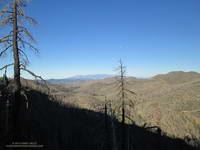
So far today the weather had been good; a little breezy in spots, but short-sleeve and shorts weather after the sun had risen and melted away the morning chill. Overnight temps at Big Bear Airport had been near freezing, and I wondered how cold it had been for the 100 milers on 9952′ Sugarloaf Mountain.
Where were the 100 milers? I had seen a couple of the rare beasts leaving the aid station as we parked at the campground for the start of the 50 mile, but that had been it. Aid station volunteers were saying only 4 or 5 100 milers had passed through ahead of us.
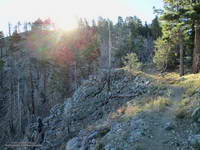
Running cohort Ann Ongena, taking advantage of all the miles of high altitude running she did at TransRockies, had picked Kodiak as her first 100. We had talked a lot about the course and the weather and I knew she was well-prepared. Because of the uncertainties of an inaugural event — particularly one of this length and complexity — we both had taken more of a self-supported adventure approach, not taking the mileages as gospel, studying the course, and putting more of what we needed in our packs and drop bags.
For the most part the running on the Pacific Crest Trail this morning had been good. I’d run the stretch of the PCT between Van Dusen Canyon Road and Delamar Mountain Road as part of the Holcomb Valley 33 Mile, but the 11 mile segment from Delamar Mountain Road to Crab Flats Road was new to me.

Much of this part of the PCT was burned in the 14,000 acre Butler 2 Fire in September 2007. Judging from the size of the trunks of the trees and shrubs, the Butler 2 fire was the first large fire in this area in many decades. Recovery is well underway, and it was great to see chest high pine saplings in some areas. Wildland fire seems to be a growing part of the outdoor experience in Southern California. It has become increasingly difficult to do a 20+ mile run and not pass through an area that has been burned in the past decade or so.
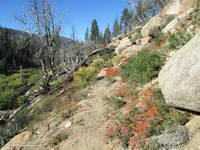
The route-finding on the 6.25 miles between Aid Stations #4 and #5 was supposed to be straightforward — stay on the single track PCT. Even with a long curved arrow on the road and pink markers at the start of the trail, the big, smooth, open, inviting dirt road was just too much of a magnet. I hadn’t run 100 yards on the PCT when we stopped to call two runners on the road back to the trail. In some cases runners followed the road all the way to aid station #5. At another point there was a nefarious truck track that diverted a number of runners off the PCT and up a hill.
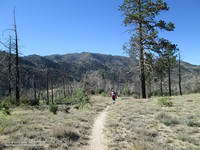
Earlier in the race some runners turned down the Cougar Crest Trail. Some caught their error within a few steps, but I talked to one runner that added four miles to his run. The junction was reasonably marked, but it is surprisingly easy to make a route-finding mistake like this. If you are not expecting and looking for a junction it can be almost invisible.
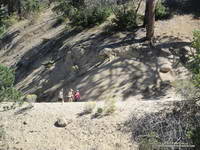
The Kodiak 50 course was carefully marked were the route-finding was intricate (Little Green Valley, Green Valley, Snow Valley, Start of Siberia Creek), but infrequently marked were there were no route choices or the route-finding was believed to be straightforward. Like the RD said in the race meeting, there were long stretches with few or no markers. Crab Flats Road comes to mind.
In some races extra markers are added for moral support. Some say too many markers. It isn’t a question of old school or new, but rather race style. This RD made it clear in the race meeting what the style of this race was going to be. Instead of extra markers I started looking at runner’s tracks and noticed a particular Hoka track. It was a smaller size and always on top of the other tracks. If I wanted confirmation I was still on route I’d look for that track, and there it would be — every time!
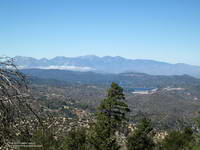 Lake Arrowhead & Baldy Peaks |
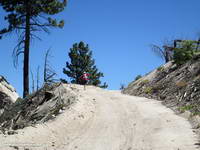 Steep Hiking |
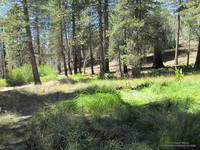 Little Green Valley |
I did a lot of looking at tracks on the way up Crab Flats Road to Green Valley, and then on other roads and trails on the way to Little Green Valley and Rim Nordic. There were a couple of runners that were sometimes a little ahead or behind me, and though we didn’t run together it was good to have company on this stretch.
I’d reached Camp #4 (~29 miles) at Rim Nordic and the Rim of the World Highway a little behind what I expected, but couldn’t complain. I was feeling pretty good. I had no foot problems; hadn’t gone off-route; hadn’t had any cramping; and had scored some BBQ ribs at the aid station.
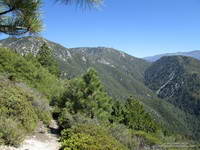
Now, as I continued down the Camp Creek Trail at mile 30-something, I scanned the steep slopes across the canyon trying to see the trace of the re-opened Siberia Creek Trail. I had little doubt that the 6.8 mile, 3000′ climb was going to be the crux of the course. Race organizers had spent untold man-days working on this trail and warned us of its difficulty. It would be a tough climb, but all I had to do was hike it. I didn’t have to clear it, mark it, or chop holds in all the trees that had fallen across the trail!
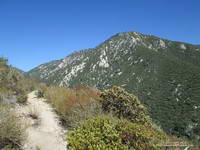
After a few more minutes of rocky downhill I finally reach Bear Creek and Water Station #3. There’s a log bridge and rope across the creek and this grinning guy is holding the rope steady for another runner to cross. It turns out the person holding the rope is Eric Bulrice, one of the race organizers. We talk for a while and he tells me he’s basically spent the summer in “Hades Canyon,” working on the Siberia Creek Trail.
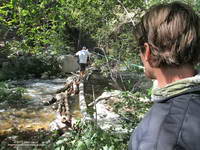
While Eric is filling up my 70 oz. Camelbak to the brim, I’m surprised to see three runners pass the water station without stopping. The course has tended to be longer and more difficult than expected and I just know I’m going to need every drop. Long story short, they and several other people run out of water part way up the climb. I tell them I will tell the aid station to send someone down.
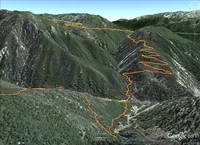
I think the best adjective I’ve heard describing the Siberia Creek Trail is that it was relentless. And it was. It just never ended. But using a term usually applied to rivers, it was also incredibly wild and scenic. I knew there was a rock formation called Gunsight not too far from the aid station, and kept looking for big boulders along the trail that fit its description. I hope to get back there soon and do the trail when I’m not in a “I have to get up this thing” mode.
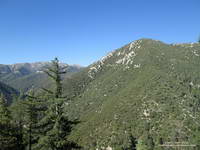
For those of us doing the Siberia Creek climb in the midafternoon, we were very fortunate to have cool weather. The Converse RAWS, which is at about 5600′ and a few miles away, topped out at 75°F at noon and was at about 71°F at 3:00 pm. Just six days before the temp had been 90°F at 2:00 pm.
The downside to that cool afternoon weather was cold weather at night. I reached Aid Station #6 (Champion Lodgepole Pine) at about 6:00 pm and it was already beginning to get chilly. A runner ahead of me had alerted aid station personnel that runners needed water and I had been glad to see a volunteer headed down the trail with a jug of water.
For spending so much time thinking, thinking, thinking about not much else except reaching the aid station, I didn’t spend much time there. The temperature was dropping and the wind was picking up. I refilled my hydration pack, had a half-cup of warm noodles and some Coke, and headed on out.
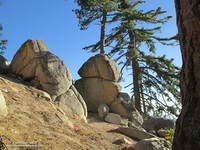
Remember those Hoka tracks I’d been following? I caught up to them part way up Siberia Creek. Turns out they belonged to Debbie Botten. She lives just over the hill from me and we have some friends in common. Shortly after dark we and Gabriel Hernandez started running together. This made a huge difference in being able to deal with the last miles of the course. Gabriel would sometimes run ahead and at one point spotted a bobcat on a log, watching us run by!
It was cold! Except for a pair of compression shorts I probably should have put on, I had on everything I’d taken — two short sleeve shirts, heavy sleeves, an ultralight shell with a hood, and gloves. It was windy up on the ridge near Grand View and I was very happy when we didn’t follow the 100 mile course along the ridgeline and began our descent.
The final stretch of dirt road paralleled Big Bear Valley, and running down it was like a slow motion nighttime approach to LAX. Ever so slowly the glowing lights of the city came up to meet us. From time to time we could hear distant cheers as runners crossed the finish line, and each time the cheers were a little louder and boosted our spirits a little more. Soon we too were running down the asphalt of Pine Knot Ave and to surprisingly enthusiastic cheers and shouts, given the hour, crossing the finish line!
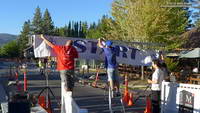 Getting Ready |
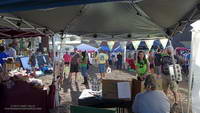 Kodiak Basecamp |
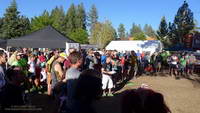 Race Meeting |
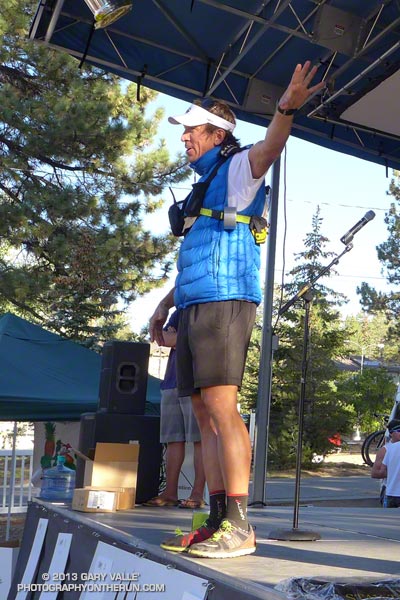 RD Paul Romero |
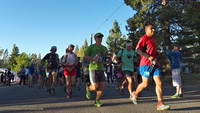 Kodiak 100 Start |
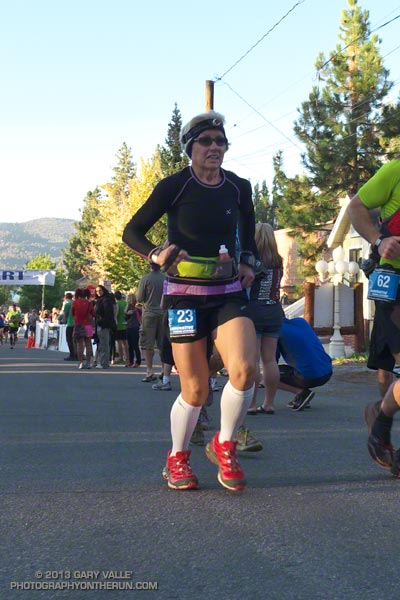 Womens 100M Winner |
Many thanks to Paul Romero, Eric Bulrice, Matt Smith, Dede Hermon, Scott & Tammy Carnohan, Sarah Sherry, Peter Brennan and Cyril Jay Rayon for the huge amount work necessary to put an event like Kodiak together. “Hey, let’s do a 100 mile course around Big Bear Lake and while we’re at it, open up a historic trail that hasn’t been maintained for decades!” Also a big THANK YOU to the volunteers. I was always greeted with a smile and all the help I needed.
Out of the 67 100 milers that started, only 19 finished and most of the favorites dropped. In a race where the top time was expected to be under 20 hours, New Hampshire’s Garry Harrington’s was the only runner to break 24 hours, coming in at 23:58:55. The top woman in the 100 miler was Jeri Ginsburg from San Diego, with a time of 29:15:10.
Runners in the 50 mile fared better. Out of 71 runners that started, only 17 dropped. Italy’s Michele Graglia put down a phenomenal 9:32:28 for the win. The top woman in the 50 mile was Kristina Tudor of Azusa, who cranked out a 12:03:20. Fifteen year old Steven Evers (remember when you were 15?) flew through the course in 11:53:31.
My friend Ann, with no regrets, called it a day at Camp #4, which we now know is at about mile 79. She had no issues and plans to do Kodiak again next year. She did have something unusual happen during the race. After running miles and miles alone up Crab Flats Road she began to wonder if she was still on course. Rounding a corner she saw a couple rummaging around in a van with bikes on it. She asked if it was a water station and was told, “Yes, but it is for a motorcycle event!’ For the moment it took to realize she was being had, she thought she was miles off course. They had a good laugh about it later. When she reached Camp #4 she texted this to her TransRockies running partner:
“I’m totally happy with 75 glorious miles, the course is just way hard so takes long. I had my night run, stars and full moon and the PCT! Happy me! Volunteering now :)”
Here is an interactive Google Earth view of the 100 mile (red) and 50 mile (yellow) courses. The view can be zoomed, panned and tilted. Placemark locations and distances are approximate. The distances are those calculated by SportTracks from the GPS tracks. If your device/browser doesn’t support the Google Earth plugin, here are a some Google Earth snapshots of several sections of the Kodiak 100/50 Mile courses:
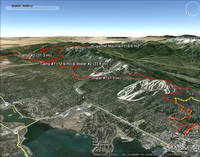 Start to Camp #2 |
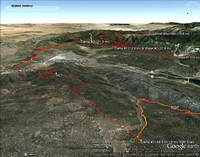 Camp #1 to Camp #3 |
 Camp #3 to Aid #4 |
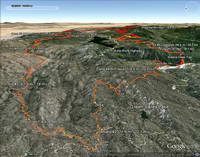 Aid #4 to Camp #4 |
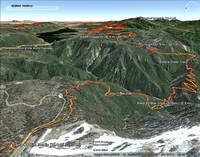 Camp #4 to Aid #6 |
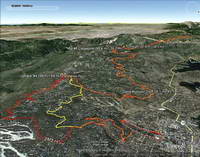 Aid #6 to Finish |
In SportTracks the 100 mile track (from Garmin Connect) worked out to 104 miles with a conservative gain/loss of +15,801 / -15,831. My 50 mile track worked out to 53 miles with a gain/loss of +8,310 / -8,861. SportTracks elevations were corrected using pkan’s Elevation Correction Plugin and NED 1/3 arc second DEMs. SportTracks elevation data smoothing was set to conservative value of 55.
For more info, full results, and photos see the Kodiak 100 web site and Facebook page.
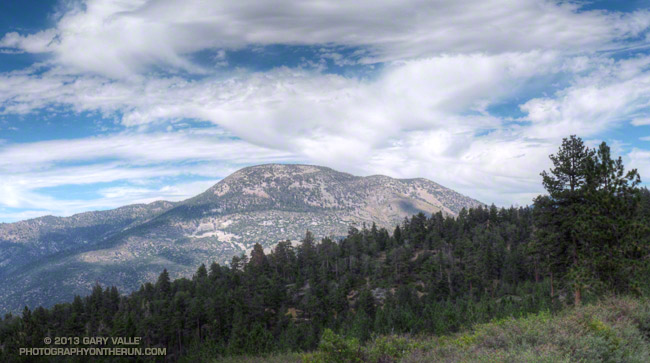
Sugarloaf Mountain (9952′) is the high point of the Kodiak 100 Ultramarathon, a new ultra being run this Friday, Saturday & Sunday, Sept 20-22, 2013, in Big Bear. A 50 mile course is also being offered.
The 100 mile race begins Friday at 6:00 p.m. at The Village of Big Bear Lake. The summit of Sugarloaf Mountain is at about mile 17.5 of the course. Assuming clear skies, runners will ascend the peak under the light of a 98% full moon. According to the U.S. Naval Observatory data, sunset on Friday will be at 6:47 p.m., with “civil twilight” ending at 7:12 p.m. Moonrise will be at 7:30 p.m. At 9:00 p.m. the moon will be about 18 degrees above the eastern horizon.
The 50 mile race begins Saturday at 6:00 a.m. at about the half-way point of the 50 mile course. Saturday, civil twilight begins at 6:10 a.m., with sunrise at 6:35 a.m. Sunset is at 6:45 p.m., with civil twilight ending at 7:10 p.m. Moonrise Saturday evening will be at 8:08 p.m.
The photo of Sugarloaf Mountain is from the South Fork Trail just above Horse Meadows on the way down from an ascent of San Gorgonio Mountain this August. The south face of Sugarloaf Mountain drops about 3800′ to the Santa Ana River east of Barton Flats.
Note: Sun and moon rise and set times depend on the altitude and location of the observer, and other factors, so may vary a few minutes from the times mentioned above.